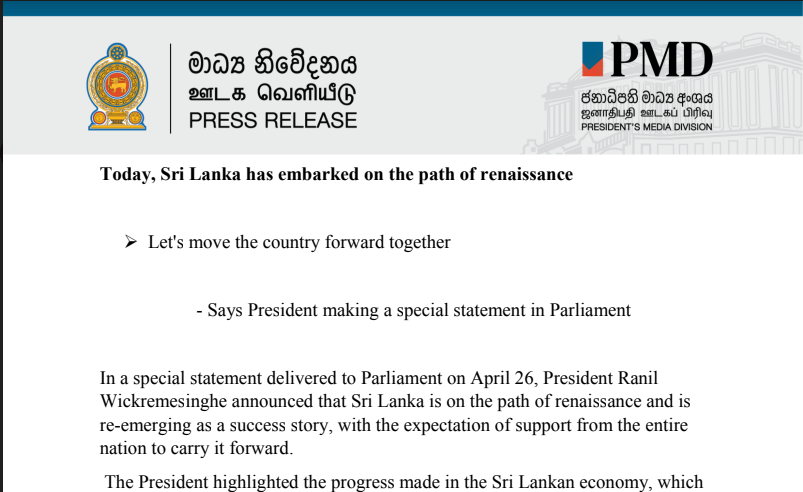– Says President making a special statement in Parliament
In a special statement delivered to Parliament on April 26, President Ranil Wickremesinghe announced that Sri Lanka is on the path of renaissance and is re-emerging as a success story, with the expectation of support from the entire nation to carry it forward. The President highlighted the progress made in the Sri Lankan economy, which had previously collapsed due to riots, arson, and state bankruptcy. In just eight
months, the country has turned its fortunes around and is now known as the ‘Sri Lanka comeback story’.
The President also spoke about the International Monetary Fund agreement which he presented to Parliament. He acknowledged that the country had failed to implement previous agreements with the International Monetary Fund, despite entering into 16 such agreements. However, the President emphasized that there is no other active option for Sri Lanka but to sign an agreement with the International Monetary Fund at present.
President Ranil Wickremesinghe reassured the public that the restructuring of local debt would not harm members of the Employees’ Provident Fund.
Furthermore, he stated that a social safety net has been implemented to protect low-income people and create financial stability in the country. With these measures in place, the President is optimistic about Sri Lanka’s
future and urged the nation to work together towards a brighter future.
Following is the full statement made by President Wickremesinghe; I would like to address the concerns that have been raised in the media and elsewhere about the economic and financial issues that our country has faced. In July 2022, Sri Lanka was hit with riots, arson, and state bankruptcy, causing a complete loss of trust in our country. However, after eight months, we have managed to turn things around and it’s now being called the Sri Lanka comeback story. We have entered the path of renaissance and are reborn, and I am counting on the support of the whole country to take it forward.
Let me give you a brief overview of the situation we faced. Our tax cuts in late 2019 cost us 4% of gross domestic product, and things only got worse with the Covid epidemic. In February 2022, the Sri Lankan Rupee depreciated by 40% against the US Dollar within three months, and it continued to depreciate.
Economic growth contracted by 7.8% throughout 2022, and inflation in September 2022 exceeded 70%, with food inflation rising as high as 95%. In this challenging backdrop, I decided to assume the presidency in July 2022 because I believed that our country could recover. If I had not taken responsibility during a time of agitations and protests, our country would have been completely destroyed. I didn’t hesitate even when the paintings in my home library were burnt down and destroyed.
At that time, Sri Lanka’s total debt was 83.6 billion US dollars, with foreign debt at 41.5 billion US dollars and domestic debt at 42 billion US dollars. By now, our overall debt ratio as a percentage of GDP has become 128%. Due to non-repayment of bilateral and private loans, the amount of outstanding debt from April to December 2022 was estimated at 2.7 billion US dollars. By the middle of 2022, Sri Lanka was unable to import goods and services from abroad due to the worsening foreign exchange deficit. In May 2022, interest
related to foreign loans failed to be paid. This was the first time in the history of Sri Lanka that we had to face such a situation.
As soon as I took over the government, I began negotiations with the International Monetary Fund, the World Bank, and the Asian Development Bank. As a result, in September, we reached an agreement with the International Monetary Fund regarding extended credit facilities.
- The comprehensive credit facility consists of six major reforms, which are as
follows:
(a) Revenue Based Fiscal Consolidation – This reform includes institutional changes related to the public finance sector, strengthening the social security network, and introducing business reforms in the public sector.
(b) Restructuring of Public Debt
(c) Implementation of multiple strategies to ensure the restoration of financial stability, including the formation of foreign reserves under a flexible foreign exchange rate regime.
(d) Implementation of relevant policies and reforms to ensure the stability of the financial sector.
(e) Implementation of structural reforms necessary to control corruption – In this regard, the Minister will present the relevant draft.
(f) Taking necessary measures to enhance economic growth
Today, we received the financing assurance from foreign creditors, with the
Paris Club and India working together to grant it.
India was the first to publish it, and we are grateful for that. China is expected to deal with it separately, so
we will discuss with the Paris Club and India on one hand and negotiate with China on the other. After these discussions, we will have talks with private creditors. This agreement will enable us to receive approximately $3 billion from the International Monetary Fund over the next four years, with the potential to obtain about $7 billion from other institutions. This money is crucial for us. Additionally, we have regained the trust of foreign banks and financial institutions, with economic stability already being established in the country.
Social Security is receiving more funding, and investors are showing a keen interest in Sri Lanka. We have entered into agreements with the International Monetary Fund 16 times in the past, but we have not fully implemented them. On the 17th occasion, when we achieve stability, we must address our long-term weaknesses and move forward with a new program.
R





